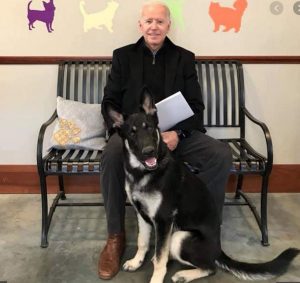When given proper feedback German Shepherds can be quite obedient dogs, in fact some of the most motivated dogs I have ever met have been GSDs. Regrettably, when they do not have a job and that determination falls into the wrong channels, a German Shepherd can become quite a menace as well. One of the more common “annoying” behaviors I see with Shepherd clients is jumping. Jumping is a difficult behavior because as a layperson, it can be so obnoxious, but as a trainer it is a tad heartbreaking simply because it is nearly always based in attention seeking.
Why Dogs Jump
To address any problem behavior it is important to address the source of the issue. Dogs jump because they want attention from us; whether it is when their owner comes home or when a new person comes over, they are just so overwhelmed with excitement they cannot contain themselves. This is cute when they are little and fluffy, but when they are 70 lbs. and haven’t had their nails trimmed recently it becomes a serious nuisance. Unfortunately for us, most guests (and pet parents) react entirely incorrectly to this behavior by, pushing the dog, yelling at the dog, telling them no/stop/off, and scowling at them. All of these reactions are actually reinforcing the behavior of jumping to seek attention, albeit unintentionally.
If your dog wants attention, and is doing a behavior (jumping), and your response to that behavior is anything that your dog interprets as attention (even if you think it’s “punishing”), your dog will be likely to repeat that behavior again. This is because dogs only do behaviors that work. In some situations dogs are self-reinforced by a behavior, but the vast majority of the time if they keep doing it, it’s because they are getting some type of reinforcement.
Examples of This
Let’s take a look at a simple example of this concept, and then a more complicated one. Max is hungry so he wanders to his food bowl, but there is nothing in it so he whines in frustration. His owner, Sally, notices this and fills his bowl for him. From now on, every time Max is hungry he sits by his bowl and whines, and Sally fills the bowl for him. Pretty simple right? The behavior (whining) resulted in a reaction that Max liked (food bowl refilled) so he repeated that behavior again.
Now for our more complicated example: Sally comes home from work with her hands full of groceries. Max is excited that she is home, and comes running up to her wagging his tail. Sally does not notice Max as she attempts to put down the groceries, so Max jumps up to get her attention. When Max jumps, Sally absentmindedly pats him on the head and tells him hello. The behavior (jumping up) resulted in the reaction that Max was seeking (attention from Sally), so what is Max likely to do next time? Jump!
Continuing with this example, the next time Sally has friends over Max comes up for attention. When they stop petting him, Max jumps on them because he still wants attention. Sally grabs him by the collar and tells him “no”. Next time Sally’s friends come over Max comes running over and jumps on them immediately.
Max’s jumping escalated because of the reactions that occurred each time. Sally’s response to Max seeking attention was to grab him and tell him “no”, this was an incorrect reaction because grabbing him could be interpreted as play, and talking to him is giving him the attention that he was seeking. Because the behavior of jumping was working more than the initial behavior of approaching with tail wagging, Max began to jump more.
So How Should You React?
So we know what Sally did was incorrect, and we know what reactions may be interpreted as attention (basically anything) so what do we do instead? The first and foremost goal should be ensuring you are not reinforcing the behavior that you dislike. If looking at him, talking to him, pushing him, and smacking him are all reinforcing him, we want to choose the Least Reinforcing Scenario or LRS.
In this case the LRS is absolute disregard of the dog. We do not look at the dog, talk to the dog, or touch the dog. You can twist or turn to knock him off of you while he is jumping, but we want to avoid any reaction he may interpret as you showing interest in him. Treat the dog as if he were a ghost, you can’t see him, hear him, or feel him. By doing this, and teaching your guests to do this, we avoid accidentally telling him that jumping gets him what he wants.
Providing an Alternative
Simply ignoring your dog will only go so far in the reduction of jumping, because the motion of repeating the behavior can become reinforcing in itself. This is why it’s important that we provide the dog with an alternative to the current (undesirable) behavior, in this case that would be basically anything besides jumping. If the dog is not jumping he can be given attention, and when he is jumping all attention ceases. It doesn’t take a rocket scientist to figure out what works in that situation, and as long as the feedback is always consistent your dog will slowly learn that he can still get attention if he is not jumping. You can also ask him to “sit”, but only while his feet are on the floor.
Preventing Repetition
Finally, our dogs fall into quite stringent behavior patterns. If your dog is used to jumping on each and every person that walks into the house, their automatic reaction to a person coming over is going to be “jump!”. The most effective way to prevent this from reoccurring (and reoccurring, and reoccurring) is to put a gate up so they cannot physically reach your guests to bombard them. We want them to be able to see, hear, and smell everyone but not jump on them. This will give you time to explain how your guests should be reacting when he tries to jump, and it will give him time to calm himself down. After ten minutes or so, you can let him out and resume your LRS until he ceases jumping.
By making sure your dog doesn’t get accidentally reinforced for jumping, you can ensure he doesn’t have a reason to continue the behavior. By adding an alternative that actually works, you give him an opportunity to get what he actually wants by doing something different than jumping. Finally, by keeping him from being able to jump on your guests for the first few minutes, we prevent the behavior from occurring in the first place. With this combination, some time, and some patience, your dog will learn their manners effectively and permanently.




